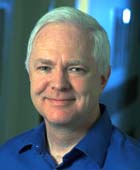Anthony Pawson was awarded the Dr H.P. Heineken Prize for Biochemistry and Biophysics 1998 for his discovery of the ‘SH2 domain’ in proteins involved in signal transduction in living cells, which has shed invaluable light on intercellular communication.
His work has yielded a better insight in the way in which cells communicate with neighbouring cells. It appears that there is a connection between interference in the transduction of external signals into a cell and diseases such as cancer, diabetes and cardiovascular diseases. Pawson’s discovery has changed our concept of signal transduction so fundamentally that it has opened up new areas for the development of medicines for these diseases.
Pawson’s work has provided a new perspective of the way in which signals move from outside a cell to its nucleus. This process involves proteins that recognise each other by certain protein domains, such as the SH2 Domain, and then bind themselves to each other. This mutual binding is disrupted if structural changes take place within the proteins, which in turn may result in the development of a tumor. The discovery has created new ways of addressing this chain of events.
Biography
Anthony J. Pawson (1952 – 2013) was Head of the Department of Molecular Biology and Cancer Research of the Samuel Lunenfeld Research Institute, Toronto, Canada. For a scientist of his age, Dr Pawson has published an extraordinarily large number of articles in prestigious international journals. His influence is therefore considerable. Not only in the fields of biochemistry, biophysics and genetics, through which research in the field of intercellular communication has made great strides, but also in the world of medical science there is tremendous interest in the theories that are being developed on the basis of Dr Pawson’s revolutionary concept.
Dr Pawson’s more recent work has demonstrated the significance of proteins with SH2 domains for the development of mammal cells. In addition, by combining genetic experiments with flies, worms and mice, he has sought to clarify the molecular mechanisms that underlie signal transduction through conduction by way of axons in the central nervous system. Dr Pawson’s research therefore remains highly innovative, which promises further insights.
